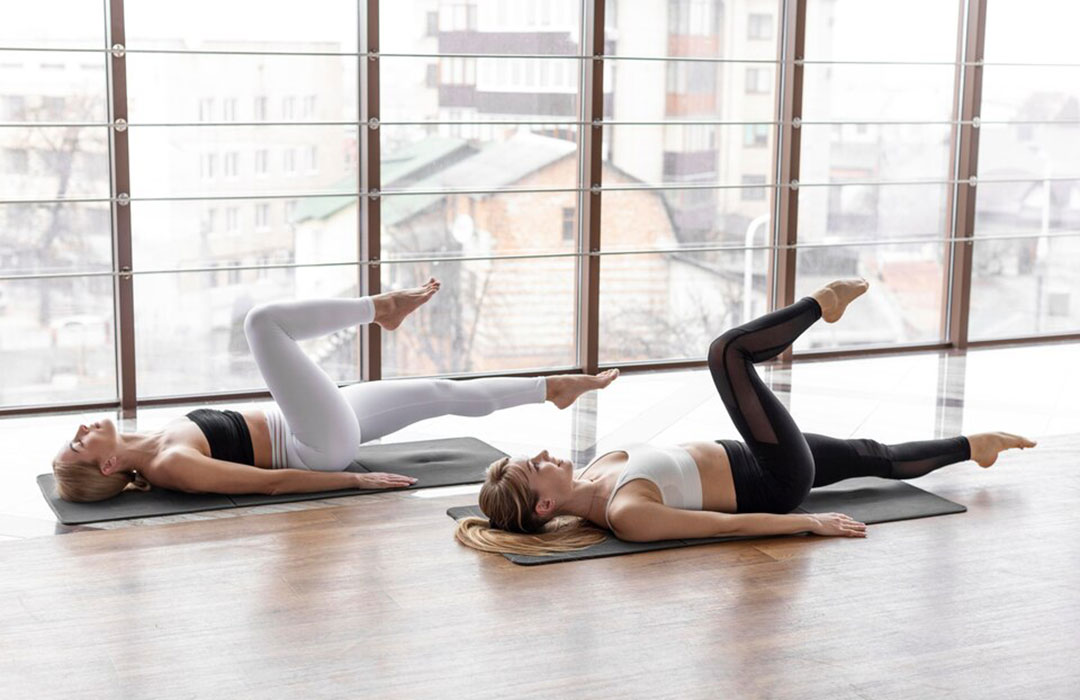Introduction
Are you looking for a holistic approach to fitness that strengthens your body and revitalizes your mind? Look no further than Restorative Pilates! This excellent exercise method combines strength training, flexibility, and mindfulness to deliver a comprehensive mind-body workout. In this article, we will delve into the world of Restorative Pilates and explore how it can help transform your body and mind. So, let’s unlock the power of Restorative Pilates together!
What is Restorative Pilates?
Restorative Pilates is a gentle yet powerful form of exercise that focuses on restoring balance and alignment in the body. It combines controlled movements, proper breathing techniques, and mindfulness to improve strength, flexibility, and overall well-being. Unlike traditional Pilates, which can be more intense and fast-paced, Restorative Pilates prioritizes relaxation, deep stretching, and conscious movement.
The Origins of Restorative Pilates
Restorative Pilates draws inspiration from the original Pilates method developed by Joseph Pilates in the early 20th century. Joseph Pilates believed that physical and mental health were closely interconnected, and he designed a series of exercises to promote holistic well-being. Over time, these exercises evolved into the diverse range of today’s Pilates practices, including Restorative Pilates.
The Principles of Restorative Pilates
Restorative Pilates follows a set of fundamental principles that guide its practice. These principles include:
- Breathing: Conscious and controlled breathing is an integral part of Restorative Pilates. It helps facilitate movement, enhances oxygen flow, and promotes relaxation.
- Alignment: Restorative Pilates emphasizes proper alignment to improve posture, reduce joint strain, and enhance overall body mechanics.
- Mindfulness: Mind-body connection is central to Restorative Pilates. By cultivating awareness and focus, practitioners can deepen their experience and achieve a state of relaxation and mental clarity.
- Core Stability: Restorative Pilates strongly emphasizes core strength, forming the foundation for overall body stability and control.
- Precision: Each movement in Restorative Pilates is performed with precision and attention to detail. This precision ensures maximum effectiveness and minimizes the risk of injury.
Benefits of Restorative Pilates
Restorative Pilates offers a myriad of benefits for both the body and mind. Here are some of the key advantages:
- Improved Flexibility: Restorative Pilates incorporates gentle stretching exercises that enhance flexibility, mobility, and range of motion.
- Enhanced Core Strength: By targeting the deep abdominal muscles, Restorative Pilates helps develop a solid and stable core, improving posture and balance.
- Muscle Tone and Strength: The controlled movements in Restorative Pilates engage and strengthen various muscle groups, resulting in a toned and sculpted physique.
- Stress Reduction: Restorative Pilates encourages relaxation, mindfulness, and deep breathing, promoting a sense of calm and reducing stress levels.
- Improved Posture: Focusing on alignment and core stability in Restorative Pilates helps correct postural imbalances and encourages an upright posture.
- Injury Rehabilitation: Restorative Pilates can benefit individuals recovering from injuries or managing chronic conditions. Its low-impact nature and focus on controlled movements make it suitable for rehabilitation.
- Mind-Body Connection: Restorative Pilates cultivates a strong connection between the mind and body, allowing practitioners to develop greater body awareness and mindfulness.
How to Get Started with Restorative Pilates
If you’re ready to unlock the power of Restorative Pilates and experience its transformative effects, here are some steps to get started:
- Find a Qualified Instructor: Look for a certified Restorative Pilates instructor who can guide you through the practice safely and effectively.
- Choose a Suitable Class: Select a class that suits your fitness level and goals. Beginners may benefit from introductory or gentle Restorative Pilates classes.
- Invest in the Right Equipment: While Restorative Pilates can be practiced using minimal equipment, having a yoga mat, comfortable clothing, and props like blocks and straps can enhance your experience.
- Start Slowly: Restorative Pilates is a journey, so be patient with yourself. Begin with basic exercises and gradually progress as your strength and flexibility improve.
- Listen to Your Body: Pay attention to your body’s cues and modify or adjust the exercises accordingly. Restorative Pilates should feel challenging yet comfortable.
- Practice Consistently: To experience the full benefits, aim to practice Restorative Pilates regularly. Consistency is key to achieving lasting results.
Common Misconceptions about Restorative Pilates
Despite its growing popularity, there are some common misconceptions about Restorative Pilates. Let’s address a few of them:
- Restorative Pilates is only for the elderly: Restorative Pilates is suitable for individuals of all ages and fitness levels. It can be adapted to meet the needs and goals of each individual.
- Restorative Pilates is too easy to be effective: While it may appear gentle, it can provide a challenging workout that targets deep muscles and enhances body awareness.
- Restorative Pilates is only for women: Restorative Pilates is a gender-neutral practice that benefits both men and women. Everyone can enjoy the transformative effects of this practice.
- Restorative Pilates is only for rehabilitation: While Restorative Pilates is beneficial for injury rehabilitation, it is also an excellent choice for individuals looking to improve their fitness, flexibility, and well-being.
Restorative Pilates vs. Traditional Pilates: What’s the Difference?
Restorative Pilates and Traditional Pilates share some similarities but also have distinct differences. Here’s a comparison between the two:
- Intensity: Traditional Pilates tends to be more intense and fast-paced, while Restorative Pilates focuses on relaxation, stretching, and controlled movements.
- Goals: Traditional Pilates aims to build strength, improve fitness, and increase endurance. Restorative Pilates prioritizes relaxation, flexibility, and restoring balance in the body.
- Breathing: Both practices emphasize proper breathing techniques, but Restorative Pilates emphasizes conscious, deep breathing for relaxation and stress reduction.
- Equipment: Traditional Pilates often utilizes specialized equipment like reformers and resistance bands. Restorative Pilates can be practiced with minimal equipment or props.
- Injury Rehabilitation: While both practices can support injury rehabilitation, Restorative Pilates is particularly suitable for individuals with injuries or those seeking a gentle approach to fitness.
Restorative Pilates Equipment: A Comprehensive Guide
Restorative Pilates can be practiced with minimal equipment, but specific props can enhance the experience. Here’s a comprehensive guide to Restorative Pilates equipment:
- Yoga Mat: A non-slip mat provides cushioning and support during floor exercises.
- Pilates Ball: Also known as a stability ball, it adds challenge and instability to exercises, targeting core muscles.
- Resistance Bands: These elastic bands provide resistance to enhance muscle strength and flexibility.
- Pilates Ring: A flexible ring-shaped prop that adds resistance and assists in toning the arms, legs, and core.
- Foam Roller: Used for self-massage and myofascial release, it helps release muscle tension and tightness.
- Blocks and Straps: These props assist in modifying exercises and providing support as needed.
Remember, while equipment can enhance your Restorative Pilates practice, it is not essential. Many exercises can be performed using only body weight.
Frequently Asked Questions (FAQs)
-
Can anyone practice Restorative Pilates?
Absolutely! Restorative Pilates is suitable for individuals of all ages and fitness levels. It can be modified to meet individual needs.
-
How often should I practice Restorative Pilates?
Aim to practice Restorative Pilates at least two to three times per week for noticeable results. Consistency is key.
-
Is Restorative Pilates suitable for individuals with injuries?
Yes, Restorative Pilates can be beneficial for injury rehabilitation. However, consulting with a qualified instructor and informing them about your injuries is essential to ensure proper modifications and support.
-
Can Restorative Pilates help alleviate back pain?
Restorative Pilates exercises focus on strengthening the core, improving posture, and enhancing spinal alignment, which can often alleviate back pain. However, it is essential to consult with a healthcare professional before starting any exercise program if you have existing back issues.
-
Will Restorative Pilates help improve my posture?
Yes, Restorative Pilates places a strong emphasis on alignment and postural awareness. Regular practice can lead to improved posture and body mechanics.
-
What should I wear to a Restorative Pilates class?
Wear comfortable, breathable clothing that allows for ease of movement. Opt for fitted or stretchy attire that does not restrict your range of motion.
Conclusion
Restorative Pilates is not just an exercise routine; it’s a holistic approach to well-being. Restorative Pilates can transform your body and mind by incorporating gentle movements, conscious breathing, and mindfulness. Whether you want to improve flexibility, build strength, reduce stress, or enhance your overall well-being, Restorative Pilates offers many benefits. So, unlock the power of Restorative Pilates and embark on a journey of self-discovery and transformation.




